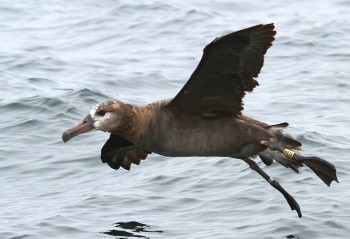David Hyrenbach (Hawai'i Pacific University, Marine Science, Waimanalo, Hawaii USA) and colleagues have published in the latest issue of the open-access journal Marine Ornithology on plastic ingestion by Black-footed Albatrosses Phoebastria nigripes foraging to the west of the Hawaiian islands.
“We quantified the incidence (percentage of samples with plastic) and loads (mass, volume) of four plastic types (fragments, line, sheet, foam) ingested by Black-footed Albatross Phoebastria nigripes chicks raised on Kure Atoll, the westernmost Hawaiian colony. All 25 samples contained plastic, mostly in the form of foam and line. On average (± SD), boluses and stomachs contained 28.2 ± 14.3 g and 40.3 ± 29.0 g of plastic, respectively. Plastic was the dominant indigestible material in the boluses and the stomach samples, accounting for 48.8%-89.7% of the bolus mass (mean 67.4 ± 12.1%, median 67.5%, n = 20), and for 18.2%-94.1% of the stomach content mass (mean 70.0 ± 30.3%, median 75.6%, n = 5). Although the ingested plastic fragments ranged widely in size, most (92% in boluses, 91% in stomachs) were mesoplastics (5-25 mm), followed by macroplastics (>25 mm; 7% in boluses, 6% in stomachs), and microplastics (1-5 mm; 1% in boluses, 4% in stomachs). Yet the two fragment size distributions were significantly different, with more small-sized items (3-8 mm) in stomachs and with more large-sized items (46-72 mm) in boluses. To investigate where albatross parents collect this material, we tracked seven provisioning adults during 14 foraging trips using satellite-linked transmitters. The tracked birds foraged west of Kure Atoll (180-150°E, 30-40°N) and spent most of their time over pelagic waters (>2000 m deep; averaging 89 ± 9%), with substantial time over seamounts (averaging 11 ± 7%). Together, these results indicate that Black-footed Albatross chicks at Kure Atoll ingest plastics sourced by their parents foraging in waters of the western North Pacific. Provisioning adults forage within an area of surface convergence, downstream from the Kuroshio Current, and frequently visit seamounts northwest of the Hawaiian archipelago.”

Black-footed Albatross at sea, photograph by Vicki Miller
Reference:
Hyrenbach, K.D., Hester, M.M., Adams, J., Titmus, A.J., Michael, P., Wahl, T., Chang, C.-W., Marie, A. & Vanderlip, C. 2017. Plastic ingestion by Black-footed Albatross Phoebastria nigripes from Kure Atoll, Hawai'i: linking chick diet remains and parental at-sea foraging distributions. Marine Ornithology 45: 225-236.
John Cooper, ACAP Information Officer, 06 November 2017

 English
English  Français
Français  Español
Español